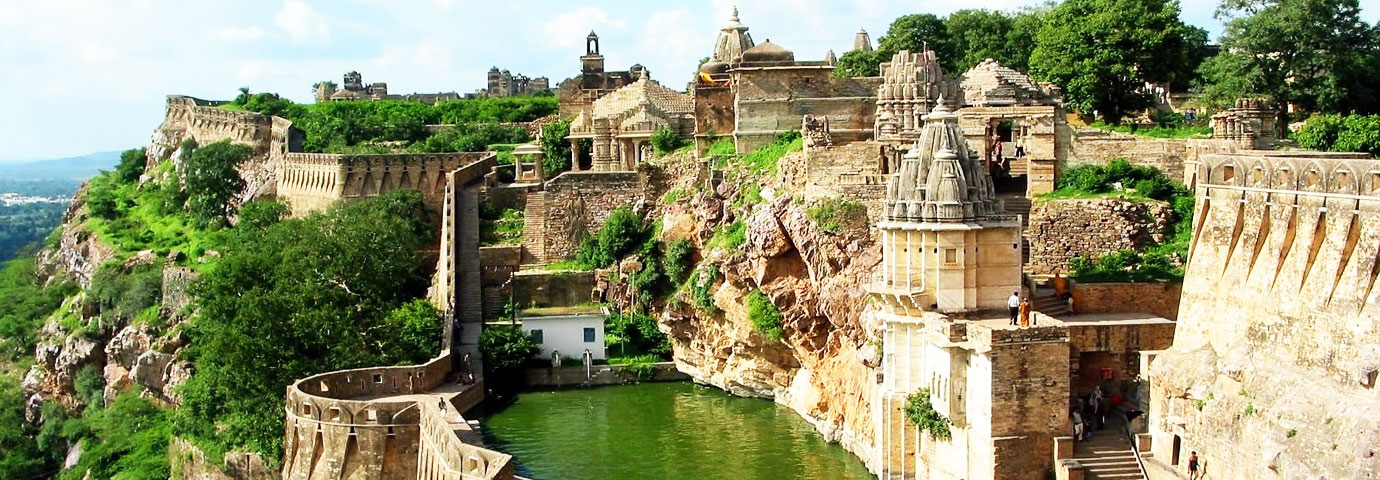Fast Facts
|
Language |
Rajasthani and Hindi |
|
Best time to visit |
Winters |
The story of Chittorgarh is a saga of valor, tenacity and sacrifice. Chittorgarh (also Chittaurgarh) was sacked three times and its defenders had to make the supreme sacrifice. The Fort of Chittorgarh is a treasure trove of history and offers to the traveler an insight into the life of the Great Rajput rulers, who laid down their lives fighting a superior enemy instead of leading a life of submission under them.
Location
Chittorgarh is located in the southern part of the state of Rajasthan, in the northwestern part of India. It is located beside a high hill near the Gambheri River. It is 112 km from Udaipur and 182 km from Ajmer. The climate of Chittorgarh is arid. Summers are quite hot (April-June) and winters are cool (October-February). It experiences scant rainfall between June and August.
Best Time To Visit
The best time to visit Chittorgarh is in winters.
History
The origin of Chittorgarh can be traced to the seventh century. Earlier it was known as Chitrakut, after a local Rajput chieftain named Chitrang. It remained the capital of the local Sisodia clan of Rajputs from the eighth to the 16th century. The history of this town is written in blood and sacrifice. Muslim rulers sacked it three times in the medieval period. The first was by Ala-ud-din Khilji, the Sultan of Delhi in 1303. Khilji laid siege of this hill fort to capture the beautiful Padmini, the queen of Chittorgarh. When the situation worsened, Bhim Singh, the ruler of Chittorgarh, led his men donned with saffron robes of sacrifice, and rode out of the fort to certain death. Inside the fort, women, including Padmini and the children, committed mass suicide or jauhar by immolating themselves on a huge pyre, rather than losing their honor at the hands of the enemy. In the middle of the 15th century, Chittorgarh gained eminence when the legendary Rajput ruler, Rana Kumbha, ruled it. He built the Vijay Stambh (Victory Tower) to commemorate his victory over Mahmud Khilji, the ruler of Malwa, in 1440. Chittorgarh was sacked again in 1535 by Bahadur Shah, the Sultan of Gujarat. The jauhar that followed the siege saw the death of 13,000 women and 32,000 Rajput soldiers. The third and final siege took place in 1568 at the hands of the great Mughal emperor Akbar. Jaimal and Kalla, two Rajput generals, valiantly defended the fort but with their death and deteriorating situation, jauhar was performed. However, Maharana Udai Singh II, the ruler of Chittorgarh, fled to Udaipur and re-established his rule. The Mughal emperor Jahangir returned Chittorgarh to its rulers in 1616.
Tourists Attractions
The main tourist attraction of the town of Chittorgarh is its fort, which is located on a steep hill beside the modern township. A zigzag ascent of about 1 km through seven gates leads the tourist to its main western gate or Rampol. On the way, one can see two chhatris or memorials of Jaimal and Kalla marking the spots where they fell while defending the fort during the siege of 1568. The main gate on the eastern side of the fort is known as the Surajpol. Though most of the monuments in the fort are in ruins, yet they reflect the glory of its great rulers.
Rana Kumbha Palace is an important spot and it is believed that Queen Padmini had performed jauhar in one of its cellars.
The Archeological Museum, the Singa Chowri Temple, and the Fateh Prakash Palace and Museum are some places to visit, adjacent to Rana Kumbha Palace.
The Victory Tower or Vijay Stambh is one of the main tourist attractions of the fort. It was built by Rana Kumbha to commemorate his victory over Mahmud Khilji, the ruler of Malwa in 1440. This 37-m, 9-storied tower has a number of balconies at each story, from where the tourist can look at the monuments within the fort. The Sammidheshwara Temple is near this tower. Gaumukh reservoir and the Palace of Queen Padmini are important spots to the south of the Rana Kumbha Palace. According to legend, Ala-ud-din Khilji, the Sultan of Delhi, was allowed to see the reflection of Queen Padmini in a mirror while she stood behind a pavilion in this palace. Ala-ud-din was so smitten by her beauty that he invaded and sacked Chittorgarh to possess her. The Tower of Fame or Kirti Stambh is another important monument. This 22-m-high tower, with carvings of Jain deities, was built in 12th century and is dedicated to Adinath, the first Jain Tirthankara (spiritual leader).
Other spots worth visiting are the Bhimtal Tank, Neelkanth Mahadev Temple, Meera Temple, Kumbha Shyam Temple, and the 8th-century Kalika Mata Temple.
Places Around Chittorgarh
Bijaipur, 40 km from Chittorgarh, is an important tourist spot, with its fort converted into a hotel. One can see ancient temples at Menhal, on Bundi-Chittorgarh road, which is 48 km from Bundi. One can also see ancient Hindu and Buddhist monuments at Nagri, which is 17 km north of Chittorgarh.
How To Reach
Chittorgarh does not have an airport of its own.
By Rail - Chittorgarh railway station is located on the western banks of Gambheri River. It has rail links with Ahmedabad, Ajmer, Udaipur, Jaipur, Kota and Delhi.
By Road - The main bus stand is also on the western banks of Gambheri River. There is good bus service for Ajmer, Bundi, Kota and Udaipur from Chittorgarh.


